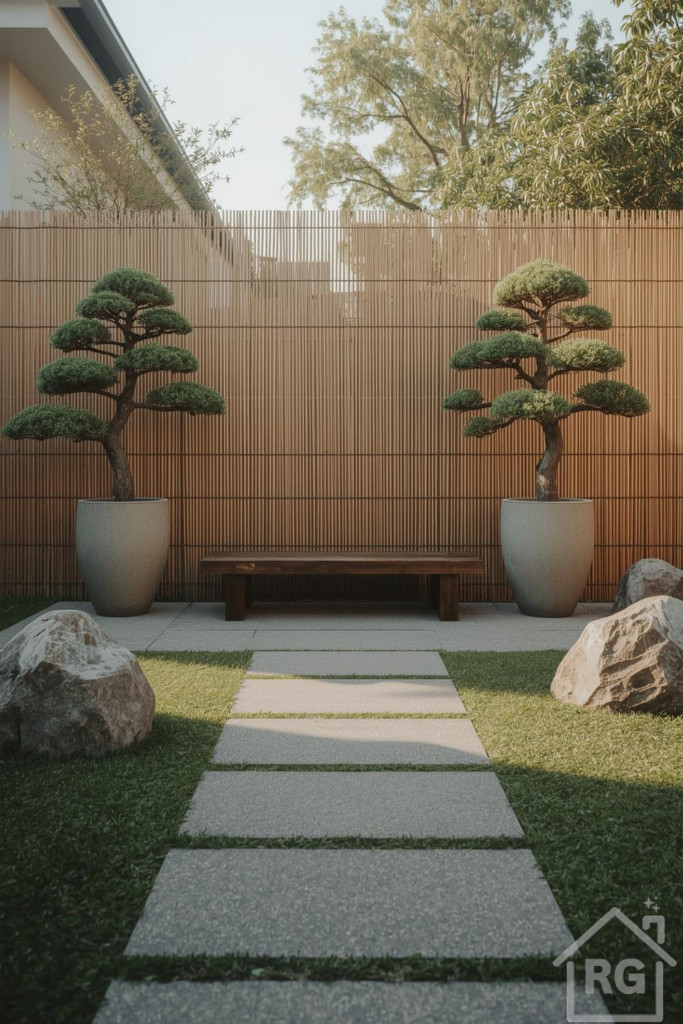
Simplicity meets profound tranquility in the world of serene outdoor living. A modern Zen garden patio is a space designed for contemplation, relaxation, and a deep connection with nature. If you’ve ever dreamed of transforming your backyard or balcony into a peaceful sanctuary, this guide will walk you through the steps to recreate this harmonious aesthetic, focusing on durable materials, thoughtful plant selection, and actionable design principles.
The Essence of Zen Design
At its heart, Zen garden design, or Karesansui, is about creating a miniature landscape that evokes the vastness of nature through minimalist elements. It emphasizes simplicity (wabi), naturalness (shizen), and subtle beauty (yugen). The goal is to foster a sense of calm and encourage introspection. This design approach achieves this through a balanced composition of natural textures, a calming color palette, and carefully chosen focal points.
A soothing visual experience is created by the dominant colors: the warm, golden hues of the bamboo fence, the deep and vibrant greens of the foliage and grass, and the cool, grounding greys of the stone. These natural tones are key to establishing a peaceful atmosphere.
Key Elements of Your Serene Zen Garden Patio
The Bamboo Backdrop: Privacy and Warmth
A tall bamboo fence is a striking feature for any Zen garden patio. Beyond its aesthetic appeal, bamboo fencing offers excellent privacy, creates a sense of enclosure, and can even help dampen noise from outside. Its vertical lines draw the eye upward, adding height and structure to the space.
- Material Choices: You can opt for rolled bamboo fencing, which is relatively easy to install and provides a natural, rustic look. For a more structured and durable option, consider pre-fabricated bamboo panels or even composite bamboo materials that offer enhanced longevity with minimal maintenance.
- Installation Tips: Ensure your bamboo fence is securely anchored to withstand wind. For natural bamboo, consider applying a UV-resistant sealant to preserve its beautiful warm brown and golden hues and prevent premature weathering.
- Benefits: Bamboo is a sustainable material, and its natural texture adds an organic warmth that contrasts beautifully with the cooler tones of stone and the vibrant greens of plants.
Grounding with Stone and Grass
The pathway and surrounding ground cover are fundamental to the Zen garden’s structure. Large, rectangular stone pavers can be laid with precise spacing, allowing lush green grass to grow between them. This creates a clean, modern look while softening the hardscaping with natural elements.
- Paver Selection: Concrete pavers are durable and come in various shades of grey, offering a contemporary feel. Natural stone options like bluestone or granite can also be used for a more organic, textured appearance. Consider their slip resistance, especially in wet climates.
- Layout Patterns: A simple, linear arrangement of pavers guides the eye and creates a clear path. You can experiment with staggered patterns or larger, irregular stepping stones for a different effect.
- Grass vs. Gravel: While grass provides a soft, vibrant green contrast, gravel is another traditional Zen garden element. If you choose gravel, opt for fine, light-colored pebbles and consider installing a weed barrier underneath for easier maintenance.
- Drainage: Ensure proper drainage beneath your pavers to prevent water pooling and maintain the integrity of your pathway.
Statement Greenery: The Art of Bonsai-Style Trees
Prominent, meticulously shaped evergreen trees in large, simple planters are central to a Zen garden’s aesthetic. These bonsai-style trees serve as living sculptures, providing focal points and a sense of timeless beauty.
- Plant Selection: For a similar look, consider dwarf conifers like Japanese Black Pine (Pinus thunbergii ‘Thunderhead’), various juniper varieties (e.g., Juniperus procumbens ‘Nana’), or even shaped boxwoods. Choose plants that are well-suited to your local climate (check your USDA hardiness zone).
- Container Choices: Large, cylindrical planters are often made of concrete or a similar composite material, in a neutral grey tone. Their simple, unadorned form allows the trees to be the star. Ensure pots have adequate drainage holes.
- Care and Maintenance: Shaping these trees requires regular pruning and care, which can be a meditative practice in itself. Research the specific needs of your chosen plant regarding watering, sunlight, and feeding. The deep green foliage of these trees provides a calming visual anchor.
The Inviting Wooden Bench
A simple, sturdy wooden bench provides a place for quiet contemplation and completes the functional aspect of a Zen garden patio. Its natural material and clean lines perfectly complement the overall minimalist design.
- Material Durability: For outdoor use, choose naturally weather-resistant woods like teak, cedar, or redwood. These woods will age beautifully, developing a lovely patina over time. Treated pine is a more budget-friendly option but may require more maintenance.
- Design and Placement: A simple, robust design emphasizes functionality and natural beauty. Place your bench where it offers the best view of your garden, allowing for moments of peaceful reflection. The rich, dark brown of the wood adds a grounding, earthy element to the space.
Natural Accents: Rocks and Boulders
Large, natural boulders are strategically placed to add an organic, sculptural element to the landscape. In Zen gardens, rocks often symbolize mountains or islands, representing stability and permanence.
- Selection: Choose rocks with interesting shapes and textures that blend naturally with your environment. Weathered, moss-covered rocks can add an ancient, timeless feel.
- Placement: Arrange rocks in odd numbers (e.g., groups of three or five) for a more natural and balanced composition. Consider their size and how they relate to other elements in your garden.
Designing Your Zen Garden Patio: Practical Tips
Recreating a tranquil Zen garden patio involves more than just selecting the right elements; it’s about thoughtful planning and execution.
- Layout and Flow: Before you begin, sketch out your patio design. Consider how you will move through the space. The pathway should invite exploration, and the seating area should feel like a secluded retreat. Define zones for different activities, even if it’s just for quiet contemplation.
- Material Selection for Longevity: Invest in high-quality, durable materials that can withstand your local climate. While natural materials are beautiful, consider their maintenance requirements. For example, some woods need regular sealing, while concrete pavers are relatively low maintenance.
- Plant Selection and Climate: Always choose plants that thrive in your specific climate zone. Research their mature size, light requirements, and water needs. For a low-maintenance Zen garden, opt for slow-growing, drought-tolerant, or evergreen varieties that retain their form year-round.
- DIY Considerations: Many elements of a Zen garden patio are achievable for the enthusiastic DIYer. Installing bamboo fencing, laying pavers, and even basic plant care can be rewarding projects. However, for complex hardscaping or large-scale planting, consider consulting with a landscape professional.
- Atmosphere Building: Subtle additions can enhance the Zen atmosphere. Consider a small, trickling water feature for soothing sounds, or discreet, low-voltage path lighting to extend the usability of your patio into the evening. Soft, warm lighting can highlight your plants and features, creating a magical ambiance.
Maintaining Your Tranquil Retreat
A Zen garden is designed for peace, and its maintenance should reflect that. The beauty of this minimalist design is its relatively low upkeep compared to more elaborate gardens.
- Regular Pruning: Keep your shaped trees and shrubs well-maintained through regular, light pruning to preserve their form.
- Weeding: Keep the grass between pavers and any other garden beds free of weeds to maintain the clean aesthetic.
- Cleaning: Periodically clean your pavers and wooden bench to remove dirt and debris. For bamboo fencing, a gentle wash and re-sealing every few years can prolong its life.
- Seasonal Care: Adjust watering schedules for your plants based on the season and monitor them for any signs of pests or diseases.
Creating your own Zen garden patio is a journey of design and self-discovery. By focusing on simplicity, natural materials, and thoughtful placement, you can transform any outdoor space into a personal sanctuary. Embrace the calming colors — the earthy browns, the serene greens, and the grounding greys — and the organic textures that define this style. Whether you’re seeking a quiet spot for morning meditation or an inviting space for peaceful evenings, this Zen garden patio offers a blueprint for tranquility. Start planning your serene escape today and enjoy the profound peace it brings.
